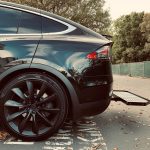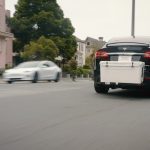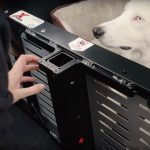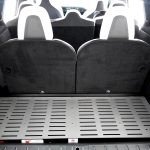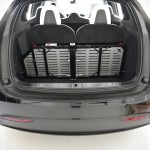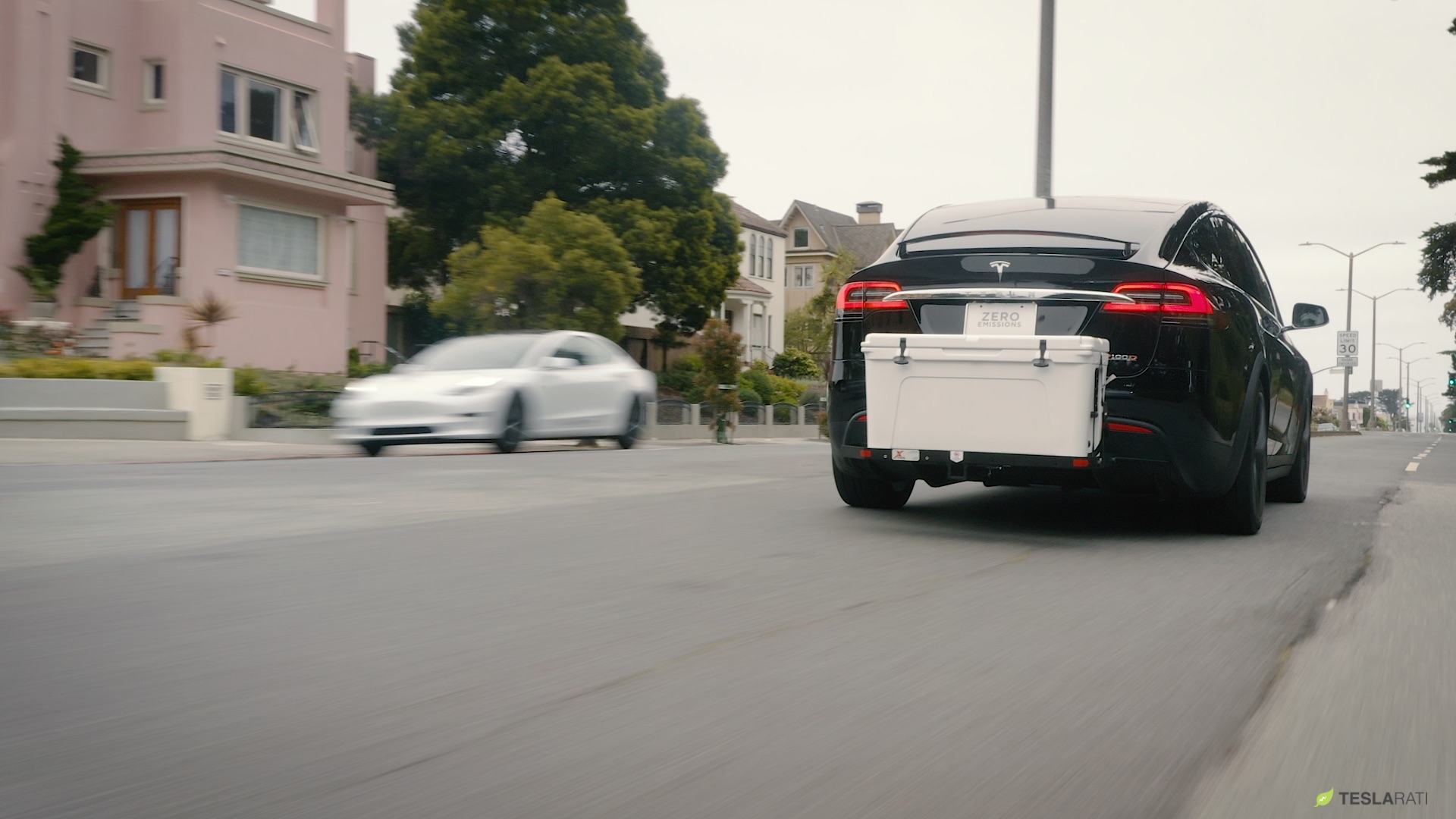
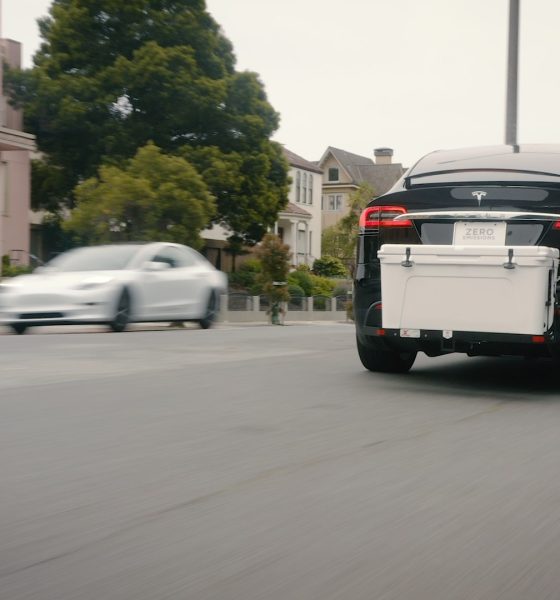
Lifestyle
X-Rack Tesla Model X cargo carrier: lightweight aluminum and custom fit for the trunk
Tesla Model X is arguably the gold standard in automotive technology and innovation, but its flashy upswing Falcon Wing door eliminates any possibility of a roof rack and roof-mounted cargo. Activities involving any sort of large luggage or hauling of gear can be a logistical challenge, especially if the excursion involves the use of Model X’s third-row seating, be it for passengers, cargo, or the family pet.
Tesla Model X owner, Nick Deninno, with his family of six, knows that all too well.
As an active New York-based Dad to four young children, the trunk area and folding third-row seats of Nick’s Tesla Model X gets plenty of use. But it has its limitations.
“I found quickly that once you have the 3rd-row seat up, all cargo space is all but lost. For a few years, I left one rear seat down on the third row and filled cargo next to my children that would eventually fall on them,” Nick tells Teslarati.
During the day, this Tesla owner runs a successful engineering and design firm. Putting his expertise in action, Nick devised a way to increase the storage capacity of his Tesla Model X, but without compromising battery range, rear-visibility, or parking in tighter locations, including Supercharging.
He called it X-Rack.
X-Rack Tesla Model X Cargo Carrier
Photo: Teslarati
Made in the USA and specifically for the Tesla Model X, the X-Rack incorporates the unique shape of the vehicle’s trunk deck into the cargo carrier’s overall shape. This design enables the rack to be at-the-ready without interfering with rear space when not in use.
X-Rack is manufactured out of lightweight aluminum as opposed to range-robbing steel and engineered to withstand cargo up to 500 lbs (227 kg).
Give Me Range
Weighing only 16.5 lbs for the ultra-light X-Lite Cargo Carrier and 21 lbs for the heavier-duty XHD carrier, both versions are extremely lightweight, corrosion-resistant due to the aluminum construction, and has a powder-coated finish.
The X-Rack was designed with efficiency in mind, both to maximum battery range and for ease of use. Unlike other steel racks on the market that are often bulky and cumbersome to use, Teslarati found the X-Rack to be relatively simple in use and can be installed or detached in roughly 90 seconds. Most of the time is spent loosening the bolt and pin that secures X-Rack to Model X’s receiver.
There’s also a sliding receiver tube that stores flush in the rack and enables Model X to return to its factory look when not in use.
Put it Away

X-Rack lightweight aluminum cargo carrier designed specifically for the Tesla Model X (Photo: Teslarati)
“The problem with hitch cargo carriers is that most are very large, heavy, and poor quality. But also you had to find a place to put it once you made it to your destination, or forced to drive around with it attached to the car for the entire trip.” – Nick, on why he decided to create X-Rack
The X-Lite and XHD Cargo Carrier can act as a replacement for Model X’s carpeted trunk floor cover or stow beneath it on a lower tier. The X-Rack can also tilt up and mimic the exact function as the factory trunk deck.
Photo: Teslarati
The frame of the X-Rack cargo carrier is powder-coated in either black or white, while the deck is offered in black or silver.
Along with color options, the X-Rack frame has a rear receiver port for additional attachments like a fishing rod carrier, a swing-out bike rack, and other lifestyle accessories. There are also mounting points on the frame for the relocation of the license plate bracket. Nick tells us that a snowboard carrier adapter and X-Rack’s snow accessory mounts are on the way, along with a variety of other solutions for nearly any cargo need.
As avid Tesla drivers, we’re all well aware of the perks offered by driving electric, especially when combined with Tesla’s extensive Supercharger network. Now, with the added convenience and flexibility of cargo transportation offered by X-Rack, that experience can be made even better.
Learn more about the X-Rack, including specifications and pricing.

Lifestyle
Tesla Model S Plaid battles China’s 1500 hp monster Nurburgring monster, with surprising results
There is just something about Tesla’s tuning and refinement that makes raw specs seem not as game-changing.

The Tesla Model S Plaid has been around for some time. Today, it is no longer the world’s quickest four-door electric sedan, nor is it the most powerful. As per a recent video from motoring YouTube channel Carwow, however, it seems like the Model S Plaid is still more than a match for some of its newer and more powerful rivals.
The monster from China
The Xiaomi SU7 Ultra is nothing short of a monster. Just like the Model S Plaid, it features three motors. It also has 1,548 hp and 1,770 Nm of torque. It’s All Wheel Drive and weighs a hefty 2,360 kg. The vehicle, which costs just about the equivalent of £55,000, has been recorded setting an insane 7:04.957 at the Nurburgring, surpassing the previous record held by the Porsche Taycan Turbo GT.
For all intents and purposes, the Model S Plaid looked outgunned in Carwow’s test. The Model S Plaid is no slouch with its three motors that produce 1,020 hp and 1,420 Nm of torque. It’s also a bit lighter at 2,190 kg despite its larger size. However, as the Carwow host pointed out, the Model S Plaid holds a 7:25.231 record in the Nurburgring. Compared to the Xiaomi SU7 Ultra’s record, the Model S Plaid’s lap time is notably slower.
Real-world tests
As could be seen in Carwow’s drag races, however, Tesla’s tech wizardry with the Model S Plaid is still hard to beat. The two vehicles competed in nine races, and the older Model S Plaid actually beat its newer, more powerful counterpart from China several times. At one point in the race, the Xiaomi SU7 Ultra hit its power limit due to its battery’s temperature, but the Model S Plaid was still going strong.
The Model S Plaid was first teased five years ago, in September 2020 during Tesla’s Battery Day. Since then, cars like the Lucid Air Sapphire and the Xiaomi SU7 Ultra have been released, surpassing its specs. But just like the Model Y ended up being the better all-rounder compared to the BYD Sealion 7 and the MG IM6, there is just something about Tesla’s tuning and refinement that makes raw specs seem not as game-changing.
Check out Carwow’s Model S Plaid vs Xiaomi SU7 drag race video below.
Lifestyle
500-mile test proves why Tesla Model Y still humiliates rivals in Europe
On paper, the BYD Sealion 7 and MG IM6 promised standout capabilities against the Model Y.

BYD is seeing a lot of momentum in Europe, so much so that mainstream media has taken every opportunity to argue that the Chinese automaker has beaten Tesla in the region. But while BYD sales this year in Europe are rising and Tesla’s registrations remain challenged, the raw capabilities of vehicles like the Model Y are difficult to deny.
This was highlighted in a 500-mile challenge by What Car? magazine, which showed that the new Tesla Model Y is more efficient, cheaper to run, and more reliable than rivals like the BYD Sealion 7, and even the nearly 400 KW-charging MG IM6.
Range and charging promises
On paper, the BYD Sealion 7 and MG IM6 promised standout capabilities against the Model Y. The Sealion 7 had more estimated range and the IM6 promised significantly faster charging. When faced with real-world conditions, however, it was still the Model Y that proved superior.
During the 500-mile test, the BYD nearly failed to reach a charging stop, arriving with less range than its display projected, as noted in a CarUp report. MG fared better, but its charging speeds never reached its promised nearly-400 kW charging speed. Tesla’s Model Y, by comparison, managed energy calculations precisely and arrived at each stop without issue.
Tesla leads in areas that matter
Charging times from 25% to 80% showed that the MG was the fastest at 17 minutes, while Tesla and BYD were close at 28 and 29 minutes, respectively. Overall efficiency and cost told a different story, however. The Model Y consumed 19.4 kWh per 100 km, compared to 22.2 for MG and 23.9 for BYD. Over the full trip, Tesla’s charging costs totaled just £82 thanks to its supercharger network, far below BYD’s £130 and MG’s £119.
What Car? Magazine’s testers concluded that despite BYD’s rapid sales growth and the MG IM6’s seriously impressive charging speeds, Tesla remains the more compelling real-world choice. The Model Y just offers stability, efficiency, and a proven charging infrastructure through its Supercharging network. And as per the magazine’s hosts, the Model Y is even the cheapest car to own among the three that were tested.
Watch What Car? Magazine’s 500-mile test in the video below.
Lifestyle
Tesla Cybertruck slapped with world’s least intimidating ticket, and it’s pure cringe
One cannot help but cringe and feel second-hand embarrassment at the idea of a person just driving around with a stack of these babies.

A Cybertruck parked at Stanford Shopping Center in California was recently hit with what might be the most try-hard piece of paper ever slipped under a wiper blade: a “fake citation” accusing the driver of supporting a “fascist car.”
The note, shared on X by Tesla staff program manager Ryan Torres, quickly made the rounds on X, where it quickly gained attention as an example of how not to protest.
The world’s least intimidating ticket
According to the citation, the supposed “violation” was “driving a fascist car.” The remedial action? Take the bus, call an Uber, or ride a bike. The note also dubbed Elon Musk a “chainsaw-wielding Nazi billionaire.” Now, protests against Tesla and Elon Musk have become commonplace this year, but one cannot help but cringe and feel second-hand embarrassment at the idea of a person just driving around with a stack of fake anti-Tesla/Musk citations.
Torres pointed out the irony himself in his post on X. Tesla currently employs over 140,000 Americans, and SpaceX has put the U.S. firmly back at the top of space technology. As Torres put it, maybe the person behind the world’s least intimidating ticket should “read a book on innovation before vandalizing” other people’s property.
Peak performative clownery
Not to mention that the fake ticket’s logic collapses under its own weight. EVs like the Cybertruck are literally designed to reduce emissions, not “destroy the economy.” If anything, Tesla has bolstered the United States’ economy by fueling jobs in engineering, manufacturing, and clean energy. It’s not the first time a Tesla has been the target of vandalism or politically charged notes, but this one stands out for sheer cringe value.
Torres summed it up neatly: “Peak clownery.” On that point, at least, the citation earns full marks. In a way, though, perhaps cringe fake tickets are not as bad as the literal firebombs that were being thrown at Tesla stores and cars earlier this year because some critics were gleefully misinformed about Elon Musk.
